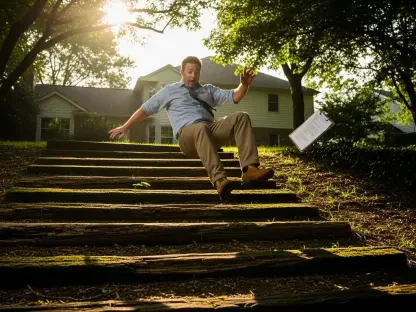As we dive into the complexities of insurance disputes in construction projects, I’m thrilled to speak with Simon Glairy, a renowned expert in insurance and Insurtech, with a sharp focus on risk management and AI-driven risk assessment. With decades of experience, Simon has navigated countless cases involving intricate policy disputes and contractor liabilities. Today, we’ll explore a recent legal battle in New York involving a slip-and-fall incident at a Bronx parking garage, uncovering the nuances of insurer responsibilities and the challenges of “additional insured” provisions. Our conversation will touch on the roles of contractors and insurers, the specifics of this ongoing case, and broader implications for the industry.
Can you walk us through the core issue in this legal dispute between two insurers over a Bronx parking garage incident?
Certainly. This case revolves around a slip-and-fall accident that occurred in a Bronx parking garage, leading to a personal injury lawsuit. The dispute is between U.S. Specialty Insurance Company and American Empire Surplus Lines Insurance Company, with the central question being which insurer should bear the cost of defending and potentially paying out for the general contractor involved. U.S. Specialty filed a complaint in federal court in New York, arguing that American Empire should step up because the general contractor was covered under their policy as an additional insured. It’s a classic standoff over who’s on the hook when multiple insurance policies are in play.
What led to the underlying incident at the parking garage, and who are the key players in the lawsuit?
The incident itself was a slip-and-fall that resulted in injuries to an individual named Natal, who then filed a lawsuit alleging negligence. The key players in the underlying suit are Natal, the injured party, and MDG Design & Construction LLC, the general contractor for the parking garage project. MDG is at the center of this because they were overseeing the site where the accident happened, and the claim targets their responsibility for maintaining safe conditions.
How does MDG Design & Construction fit into this project, and why are they named in the personal injury claim?
MDG was the general contractor hired to manage the construction or renovation of the parking garage. As the overseeing entity, they’re responsible for the overall safety and coordination of the site. They’re named in the personal injury claim because the injured party alleges that negligence on MDG’s part—perhaps in failing to address hazards or properly supervise subcontractors—contributed to the accident. It’s common in these cases for the general contractor to be held accountable, even if a subcontractor’s work might be directly involved.
Can you explain the role of the subcontractor in this project and their connection to the insurance policies at issue?
The subcontractor here is AMB Construction, Inc., tasked specifically with roof repairs at the garage. American Empire issued an insurance policy to AMB, and under that policy, MDG was named as an additional insured. This means MDG should, in theory, have coverage under American Empire’s policy for liabilities arising from AMB’s work. Meanwhile, U.S. Specialty also insured MDG directly, creating overlapping coverage that’s now the source of contention over who should defend and pay for the claim.
Why is U.S. Specialty pushing for American Empire to take on the defense of MDG in this case?
U.S. Specialty’s argument hinges on the idea that since MDG is an additional insured under American Empire’s policy with AMB, and the incident may relate to AMB’s roof work, American Empire should be the primary insurer to step in. They’ve pointed to testimony from MDG’s construction manager, which confirms AMB was actively working on the garage at the time of the incident. U.S. Specialty believes this evidence ties the claim to American Empire’s coverage obligations, relieving them of the burden.
What steps did U.S. Specialty take to get American Empire to assume responsibility for defending MDG?
U.S. Specialty made multiple attempts to hand over the defense. They first tendered the defense and indemnification of MDG to American Empire, and later, on May 30, 2025, their attorneys sent a supplemental letter reiterating the request. Despite these efforts, they claim American Empire didn’t respond or take on the defense, leaving U.S. Specialty to cover the costs and handle the legal responsibilities in the meantime.
What specific outcomes is U.S. Specialty seeking from the court in this lawsuit?
U.S. Specialty is asking for a declaratory judgment from the court to confirm that MDG is indeed an additional insured under American Empire’s policy for this specific incident. They also want the court to rule that American Empire must defend and indemnify MDG on a primary basis, meaning U.S. Specialty can step back. On top of that, they’re seeking reimbursement for all the costs and expenses they’ve incurred defending MDG so far, plus interest on those amounts.
How often do you see disputes like this between insurers in the context of construction projects?
These disputes are quite common, unfortunately. Construction projects often involve multiple layers of contractors and subcontractors, each with their own insurance policies, and additional insured provisions can create a lot of gray areas. A typical sticking point is determining whose policy is primary versus excess, or whether the scope of work directly ties to the incident. Misunderstandings or disagreements over policy language and obligations frequently lead to one insurer pointing fingers at another, as we’re seeing here.
What challenges or pitfalls often arise with “additional insured” provisions in insurance policies for construction work?
“Additional insured” provisions are a minefield because they’re often not as clear-cut as people assume. One big challenge is the specific wording of the endorsement—does it cover all operations, or just specific tasks? Another issue is proving the connection between the subcontractor’s work and the incident; if it’s ambiguous, insurers can argue over liability. Plus, there’s the practical problem of communication and coordination between insurers, which can delay defense efforts and rack up costs, as seems to have happened in this case.
Looking ahead, what is your forecast for how disputes over additional insured coverage might evolve in the construction and insurance industries?
I think we’re going to see more standardization in policy language as these disputes continue to clog up courts, but that’s a slow process. Technology, like AI-driven risk assessment tools, could help by predicting potential coverage gaps before projects even start, allowing for clearer contracts and endorsements. However, with construction projects becoming more complex and involving more parties, I expect these battles over who pays will persist. Insurers might also push for more mandatory mediation clauses to resolve these issues out of court and save on legal costs. It’s an area ripe for innovation, but change won’t happen overnight.









